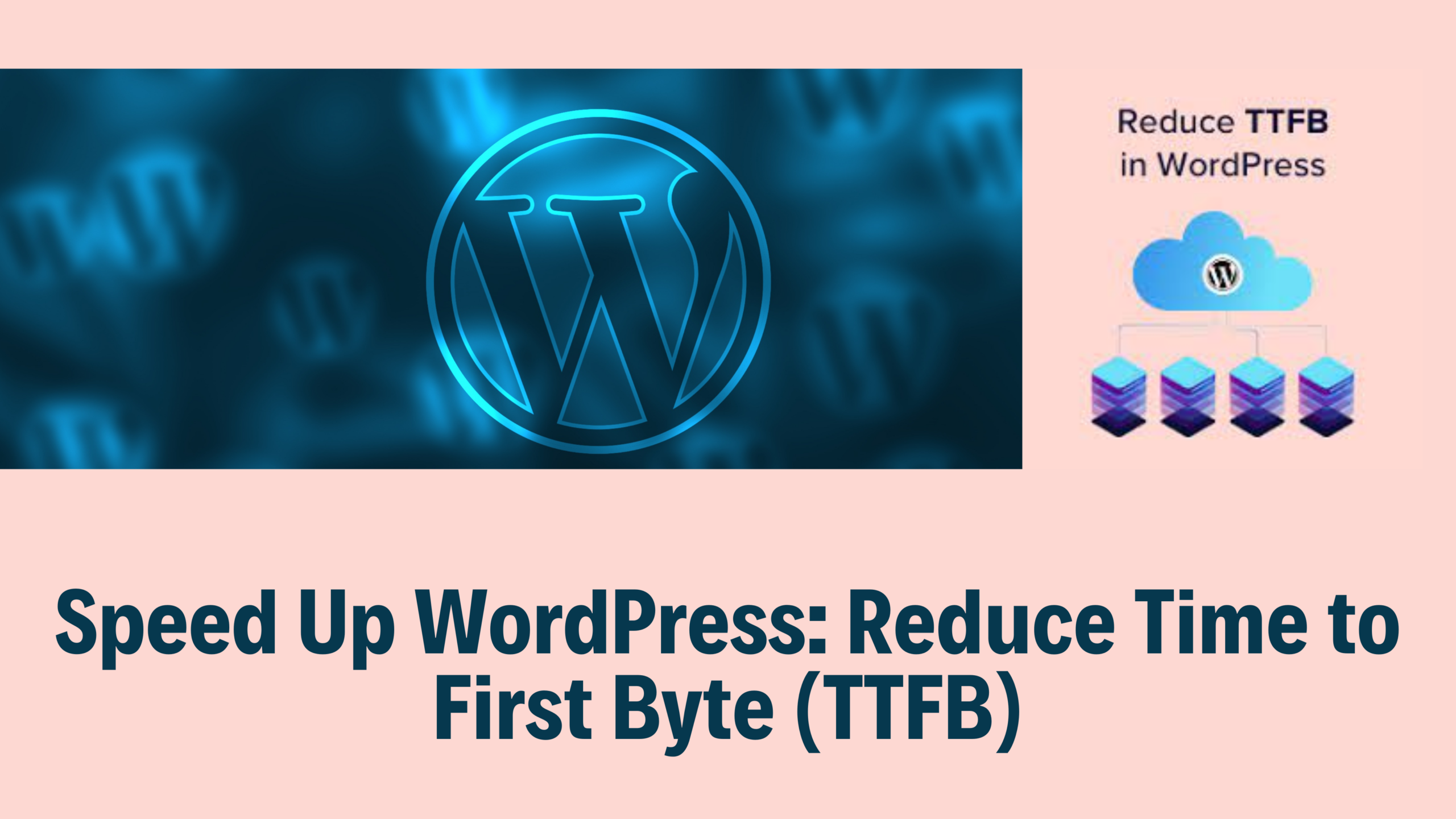Table of Contents
ToggleOptimizing WordPress: Decreasing Time to First Byte (TTFB) and Server Response Times
If you’ve ever run a PageSpeed Insights test, you’ve likely encountered the recommendation to “Reduce initial server response time.” This directive directly impacts overall loading speed and performance metrics like Largest Contentful Paint, a crucial aspect of Core Web Vitals. Hence, it significantly influences your PageSpeed score.
The aim here is to decrease the time it takes for your server to respond, ultimately lowering your site’s Time to First Byte (TTFB). TTFB indicates the duration from when a browser initiates a connection to the server to when it begins downloading the webpage’s content. Thus, enhancing TTFB leads to better performance.
How to Reduce Time to First Byte in WordPress, Understanding TTFB and its causes is essential in addressing this issue. By reducing TTFB, you can enhance your page loading speed and elevate your LCP grade, thereby improving user experience and potentially boosting search engine rankings.
While optimizing TTFB and server response times might seem daunting, there are beginner-friendly methods to achieve this on WordPress. These include leveraging optimization plugins, utilizing a Content Delivery Network (CDN), or switching to a faster web hosting service.
Previously, TTFB sparked debates within the SEO and web performance communities, with some dismissing it as insignificant while others emphasized its importance. Nonetheless, TTFB remains a valuable metric to gauge website performance.
In essence, TTFB measures the time it takes for the first byte of data to travel from the server to the visitor’s browser. It’s crucial because it signifies the initial waiting time users endure when accessing your site.
In this comprehensive guide, we’ll delve into the concept of TTFB, its significance, methods for accurate measurement, and practical strategies to reduce both TTFB and server response times. Whether you’re building a WordPress website or seeking to enhance an existing one’s speed, understanding and optimizing TTFB is paramount for delivering an optimal user experience.
What is the Time to First Byte (TTFB) in Website Performance
In simple terms, Time to First Byte (TTFB) signifies the duration from clicking a webpage link to the browser receiving the first response. It’s a crucial metric in web performance, measuring how swiftly a server delivers the initial byte of data in response to an HTTP request.
The TTFB process initiates with the HTTP request, traversing factors like network speed, geographical distance, and potential interruptions. Subsequently, the server undertakes request processing tasks, including script execution, database queries, and communication with other systems. Finally, the server dispatches the response, influenced by server speed and user internet connection quality.
TTFB’s significance is evident in its impact on webpage loading times; prolonged TTFB translates to delayed page rendering, adversely affecting user experience. Despite debates among experts about its importance, enhancing TTFB remains a worthy pursuit, aligning with efforts to optimize server responsiveness and overall site speed.
It’s essential to differentiate TTFB from Server Response Time; while the latter gauges server speed, TTFB encompasses the entire process, including network latency, offering a more holistic view of user experience.
Improving TTFB involves optimizing each step of the request-response cycle, addressing factors like DNS lookup, server processing efficiency, and network speed. By prioritizing TTFB reduction, website owners can enhance user satisfaction, search engine rankings, and overall site performance.
Exploring Various Methods to Measure Time to First Byte (TTFB)
Measuring your Time to First Byte (TTFB) is pivotal for understanding your website’s performance. Numerous tools offer insights into this crucial metric, each with its own methodology and considerations. Here, we’ll delve into several options for TTFB measurement, providing a comprehensive overview to help you gauge your website’s responsiveness accurately.
- Google Chrome DevTools: Utilizing Chrome’s built-in DevTools, you can assess TTFB directly within your browser. By inspecting network activity, you’ll find the TTFB under the Waterfall column. Although convenient, note that your network conditions may influence results.
- Geekflare’s Tool: Geekflare offers a straightforward TTFB testing tool, providing quick insights into your website’s performance. With results from multiple global locations, you can evaluate TTFB variations across regions, aiding in targeted optimizations.
- WebPageTest: WebPageTest offers comprehensive website performance analysis, including TTFB assessment. By inputting your URL, you’ll receive detailed reports featuring TTFB metrics, aiding in understanding your site’s responsiveness and potential areas for improvement.
- Sucuri Performance Tool: Sucuri’s specialized tool facilitates TTFB measurement across different geographic regions. By simulating various test scenarios, you can identify performance discrepancies and optimize your website accordingly.
- KeyCDN Performance Test: KeyCDN’s performance testing tool offers TTFB analysis from multiple global locations simultaneously. By assessing TTFB variations based on geographical proximity, you can tailor optimizations to enhance user experience worldwide.
- Pingdom and GTmetrix: Both Pingdom and GTmetrix provide TTFB measurement capabilities alongside comprehensive website performance analysis. With features like geographic selection and detailed performance reports, these tools offer valuable insights for optimizing TTFB and overall site speed.
- Other Methods: Beyond dedicated tools, you can measure TTFB through platforms like Google Analytics, which provides average response time data. Additionally, Chrome DevTools and third-party tools like ByteCheck offer alternative avenues for TTFB assessment.
Understanding TTFB Measurement: When assessing TTFB, aim for a score below 100ms for optimal performance. Scores between 200ms and 500ms are still acceptable, while anything above 600ms indicates potential performance issues. Remember, TTFB measurement may vary slightly across tools due to differing methodologies and network conditions.
By leveraging these diverse measurement methods, you can gain comprehensive insights into your website’s TTFB, empowering informed optimizations to enhance user experience and overall performance.
Importance of Reducing TTFB in WordPress
Reducing Time to First Byte (TTFB) is Crucial for WordPress Websites
Understanding why reducing Time to First Byte (TTFB) is essential for WordPress sites is paramount for optimizing user experience and maximizing performance.
TTFB directly impacts your site’s speed and responsiveness, reflecting the server’s ability to promptly respond to user requests. By minimizing TTFB, you enhance user experience, ensuring visitors encounter swift page loading times. This improvement translates into increased engagement, higher conversion rates, and ultimately, greater revenue generation.
Research underscores the significant consequences of even minor delays in page load times. A mere 1-second delay can result in a 7% decline in conversions, a 16% reduction in customer satisfaction, and an 11% decrease in page views. These statistics underscore the critical role TTFB plays in shaping user perception and driving desired outcomes on your WordPress site.
Furthermore, optimizing TTFB can positively impact WordPress SEO efforts. While TTFB itself is not a Core Web Vitals metric, it serves as a diagnostic tool for identifying underlying issues that may affect overall performance. By addressing TTFB issues, you lay the foundation for improving Core Web Vitals metrics and enhancing your site’s visibility and ranking in search engine results.
In essence, prioritizing TTFB optimization in WordPress ensures a seamless user experience, fosters higher engagement, and strengthens your site’s competitive edge in the digital landscape.
Time to First Byte (TTFB) in website performance is a metric worth optimizing to enhance both user experience and Core Web Vitals scores. However, it’s crucial to distinguish TTFB from overall page speed, as it specifically measures site responsiveness.
While opinions on TTFB’s significance have varied within the SEO and web performance communities, understanding its role is essential. TTFB provides insights into server responsiveness, highlighting potential issues like server overload. Despite differing perspectives, optimizing TTFB remains within website owners’ control, presenting an opportunity to enhance site speed and performance.
Contrary to claims that TTFB is meaningless due to its dependence on user environments, leveraging TTFB metrics across various devices and regions provides valuable insights. While network latency is beyond direct control, minimizing data transfer requirements can mitigate delays caused by latency, ultimately improving user experience.
In essence, TTFB serves as a valuable metric for gauging user experience across diverse environments, making it a pivotal factor in website optimization efforts.
How to Check TTFB on Your WordPress Website
Checking the Time to First Byte (TTFB) of your WordPress website is crucial for optimizing its performance. Here are straightforward methods and tools to help you measure TTFB:
- Google PageSpeed Insights:
- Visit the Google PageSpeed Insights website and input your website URL.
- Click the ‘Analyze’ button to initiate the analysis.
- The tool provides an overall rating out of 100, along with Core Web Vitals and TTFB metrics.
- Google Chrome Developer Tools:
- Right-click on your webpage and select ‘Inspect’, or use the keyboard shortcut Ctrl + Shift + I (Windows) or Cmd + Opt + I (Mac) to open Developer Tools.
- Switch to the ‘Network’ tab.
- Hover over the green bars under the Waterfall column to see a popup with various metrics.
- Note the ‘Waiting for server response’ time, which indicates the TTFB for your site.
- GTmetrix:
- Visit the GTmetrix website and enter your site URL.
- Click the ‘Analyze’ button and wait for the tool to analyze your site.
- Switch to the ‘Waterfall’ tab to view the response time for your web page resources and elements, where TTFB is labeled as ‘Waiting’.
These methods provide valuable insights into your website’s TTFB, helping you identify areas for optimization and enhancing overall performance.
Common Causes of High Time to First Byte (TTFB) and Their Impact on Website Performance
Time to First Byte (TTFB) is influenced by various factors that can impact website performance. Here are some common issues that may negatively affect your TTFB score:
- Long Redirect Chains:
- Multiple redirects or a lengthy redirect chain can delay the initiation of page loading, resulting in a higher TTFB score.
- Slow application processing or numerous redirects before loading the actual page content can significantly impact TTFB.
- Connection Issues:
- Various connection issues can contribute to a slower TTFB and overall page speed.
- Slow DNS lookups, particularly for first-time visitors, can delay the initial connection to the website.
- SSL connection issues or problems with downstream connections at data centers can also hinder TTFB performance.
- Insufficient Server Resources:
- Inadequate server resources are a common cause of slow TTFB, where the origin server takes longer to process the root HTML request and deliver a response to the browser.
- Hosting plans with limited CPU or memory resources may struggle to efficiently serve website content, leading to delays in TTFB.
- Shared hosting environments, where multiple websites compete for resources on the same server, can exacerbate TTFB issues.
- Hosting plans lacking optimal performance features, such as slower data I/O, traditional disk drives instead of SSDs, or limited bandwidth capabilities, may contribute to slower TTFB scores.
Addressing these factors and optimizing server configuration, reducing redirect chains, resolving connection issues, and ensuring adequate server resources can help improve TTFB performance and enhance overall website speed and user experience.
High Time to First Byte (TTFB) can significantly affect website performance, leading to slower loading times and a poor user experience. Here are some common causes of high TTFB and their implications:
- Slow Server Performance:
- Servers that are not optimized for WordPress or are overloaded with resource-intensive tasks can result in high TTFB.
- Shared hosting environments where multiple websites compete for server resources can also contribute to sluggish server performance.
- Geographical Server Location:
- Websites hosted on servers located in just one geographical area may experience high TTFB for visitors residing farther away.
- Increased network latency due to distance from the data center can lead to longer wait times for users accessing the website from distant locations.
- Server Configuration Issues:
- Configuration issues with the server, such as improper settings or outdated software, can impact TTFB.
- Resolving server configuration issues may require intervention from the web host to optimize server settings.
- Server Saturation:
- High levels of traffic and concurrent requests can overwhelm the server, causing delays in processing and delivering content.
- Basic hosting plans may struggle to handle sudden spikes in traffic, resulting in increased TTFB during periods of rapid growth.
- Slow DNS Response Times:
- Utilizing a DNS provided by the web host, which may not be optimized for speed, can lead to slow server response times and high latency.
- Premium DNS services offer faster response times and can help improve overall TTFB performance.
- Unoptimized Content:
- Large file sizes, excessive database queries, and unoptimized content can contribute to high TTFB.
- Optimizing content, such as compressing images, minimizing database queries, and reducing file sizes, can help alleviate TTFB issues.
Addressing these common causes of high TTFB is essential for optimizing website performance and delivering a seamless user experience. By addressing server-related issues, optimizing content, and utilizing efficient DNS services, website owners can significantly reduce TTFB and improve overall site speed.
Effective Strategies to Improve Server Response Times (TTFB) on WordPress
Reducing Time to First Byte (TTFB) is crucial for enhancing website performance and user experience on WordPress. Here are six proven methods to optimize TTFB and server response times effectively:
- Optimize for Core Web Vitals:
- Install a plugin like Jetpack Boost to target improvements in Core Web Vitals, including Largest Contentful Paint (LCP) and First Contentful Paint (FCP). This plugin optimizes website speed and enhances overall user experience, thereby potentially improving TTFB scores.
- Use a Content Delivery Network (CDN):
- Implement a CDN such as Jetpack CDN to reduce latency and improve loading times for visitors worldwide. CDNs distribute static content across multiple servers, ensuring faster delivery to users regardless of their geographical location.
- Leverage Page Caching:
- Enable page caching to generate HTML files directly, reducing server processing time and speeding up content delivery. Utilize plugins like WP Super Cache to implement caching efficiently and enhance website performance.
- Migrate to a Faster Web Host:
- Consider migrating to a web host with faster servers and optimized infrastructure to reduce TTFB. Choose managed WordPress hosting plans that offer scalable resources and advanced features tailored for WordPress websites.
- Use the Latest PHP Version:
- Ensure your WordPress site runs on the latest PHP version to benefit from improved performance and security enhancements. Regularly update PHP, themes, and plugins to optimize server response times and strengthen website security.
- Use a Premium DNS Provider:
- Upgrade to a premium DNS provider with a global network of servers to reduce DNS lookup times and enhance server response times. Enable DNS prefetching to instruct browsers to perform DNS lookups in advance, further optimizing website performance.
By implementing these strategies, WordPress website owners can effectively reduce TTFB and improve server response times, resulting in faster loading speeds and enhanced user satisfaction.
Impact of TTFB on User Experience in WordPress Websites
Time to First Byte (TTFB) plays a crucial role in shaping the user experience on WordPress sites. Here’s how TTFB impacts user engagement and satisfaction:
- Page Speed and User Engagement:
- TTFB directly influences overall page speed. Maintaining a low TTFB is vital for ensuring quick page loading times.
- Research indicates that even a one to three-second increase in page load time can result in a 32 percent increase in the likelihood of visitors leaving your site.
- Faster loading times contribute to a smoother browsing experience, keeping users engaged and less likely to bounce off your site.
- Conversion Rates and Sales:
- A good TTFB score can positively impact conversion rates and sales. Faster-loading pages lead to a better user experience, which can encourage visitors to take desired actions such as making purchases or filling out forms.
- Improved TTFB can streamline the user journey, making it easier for visitors to navigate your site and complete transactions.
- Impact on Core Web Vitals:
- TTFB optimization can contribute to better performance on Core Web Vitals metrics such as Largest Contentful Paint (LCP), First Contentful Paint (FCP), and Cumulative Layout Shift (CLS).
- By reducing TTFB, you enhance the overall user experience, which reflects positively on these key performance indicators.
- SEO and Search Engine Rankings:
- Google considers both page speed and Core Web Vitals as important ranking factors in its search algorithms.
- Websites with faster loading times and better performance on Core Web Vitals metrics tend to rank higher in search engine results pages (SERPs).
- Improving TTFB can lead to higher search engine rankings, resulting in increased organic traffic to your WordPress site.
In conclusion, optimizing TTFB is essential for delivering a seamless and enjoyable user experience on WordPress websites. By prioritizing TTFB improvement, site owners can enhance engagement, boost conversion rates, and improve search engine visibility.
Also Read WordPress page vs post
FAQ’s for How to Reduce Time to First Byte in WordPress
What is Time to First Byte (TTFB), and why is it important for WordPress websites?
Time to First Byte (TTFB) is the time taken for a web server to respond to a request from a user's browser. It's crucial for WordPress websites because it directly impacts page speed and user experience. A lower TTFB means faster loading times, which can lead to higher engagement, improved SEO, and better conversion rates.
How can I check the Time to First Byte (TTFB) of my WordPress website?
You can use various tools and methods to check your website's TTFB. Options include using Google PageSpeed Insights, Google Chrome developer tools, or GTmetrix. These tools provide insights into your website's performance metrics, including TTFB, allowing you to monitor and optimize accordingly.
What factors can contribute to a high Time to First Byte (TTFB) on a WordPress site?
Several factors can lead to a high TTFB on a WordPress site, including slow servers, server configuration issues, server saturation due to high traffic, slow DNS response times, and unoptimized content such as large files and excessive database queries. Identifying and addressing these issues is essential for optimizing TTFB.
Why is it essential to prioritize reducing Time to First Byte (TTFB) for WordPress site owners?
Prioritizing the reduction of TTFB is crucial for WordPress site owners because it directly impacts website performance, user experience, and SEO rankings. By improving TTFB, site owners can achieve faster loading speeds, lower bounce rates, higher engagement, and better search engine visibility, ultimately leading to increased traffic and conversions.
How can I check the Time to First Byte (TTFB) of my WordPress website?
You can use various tools and methods to check your website's TTFB. Options include using Google PageSpeed Insights, Google Chrome developer tools, or GTmetrix. These tools provide insights into your website's performance metrics, including TTFB, allowing you to monitor and optimize accordingly.







